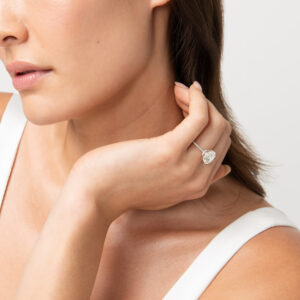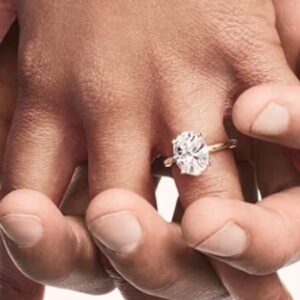What Are the 4 Cs of Diamonds: A Comprehensive Guide
When it comes to purchasing a diamond, understanding the 4 Cs is essential. The 4 Cs – Cut, Color, Clarity, and Carat Weight – are the globally recognized standards for assessing the quality of a diamond. Developed by the Gemological Institute of America (GIA) in the 1940s, these criteria provide a comprehensive framework for evaluating and comparing diamonds. This guide will delve into each of the 4 Cs, helping you make an informed decision when buying a diamond.

The First C: Cut
The cut of a diamond is arguably the most critical factor in determining its beauty. A diamond’s cut refers to how well the diamond has been shaped and faceted from its raw form. Unlike color, clarity, and carat weight, which are dictated by nature, the cut is influenced by human hands. The precision and skill with which a diamond is cut can significantly affect its brilliance, sparkle, and overall aesthetic appeal.
Understanding Diamond Cut
The quality of a diamond’s cut is assessed based on three main components:
- Proportions: The angles and relative measurements of the diamond’s facets.
- Symmetry: The alignment and balance of the diamond’s facets.
- Polish: The quality of the diamond’s surface finish.
Cut Grades
GIA assigns cut grades ranging from Excellent to Poor. These grades reflect how effectively a diamond interacts with light to produce brightness.
- Excellent: The diamond reflects nearly all light that enters it, offering exceptional brilliance and sparkle.
- Very Good: The diamond reflects most light, producing a high level of brilliance and sparkle.
- Good: The diamond reflects much of the light, but less than a Very Good cut.
- Fair: The diamond reflects some light but does not exhibit optimal brilliance and sparkle.
- Poor: The diamond reflects very little light, resulting in minimal brilliance and sparkle.
Importance of Cut
A well-cut diamond will appear more brilliant and beautiful than a poorly cut diamond of the same carat weight, color, and clarity. Therefore, prioritizing the cut when selecting a diamond is crucial for achieving the best visual impact.
The Second C: Color
The color of a diamond refers to the presence of any hue within the diamond. Diamonds are graded on a color scale from D (colorless) to Z (light yellow or brown). The less color a diamond has, the higher its color grade and value.
Understanding Diamond Color
- Colorless (D-F): These diamonds are incredibly rare and valuable, exhibiting no color. They are the most desirable for their pure, icy appearance.
- Near Colorless (G-J): These diamonds have slight traces of color, which are difficult to detect with the naked eye. They offer excellent value and appear colorless when mounted.
- Faint Color (K-M): These diamonds have a slight yellow, brown, or gray tint, more noticeable to the naked eye. They are more affordable and can still be beautiful, especially in certain settings.
- Very Light Color (N-R): These diamonds exhibit a more apparent color, but can be a budget-friendly option for those less concerned with a perfect color grade.
- Light Color (S-Z): These diamonds have a noticeable color that is visible to the naked eye. They are the least expensive and can be a unique choice for certain styles.
Importance of Color
While colorless diamonds are the most sought after, the slight differences in color are often hard to detect. Choosing a diamond in the near-colorless range (G-J) can provide excellent value without sacrificing visual appeal.
The Thir d C: Clarity
Clarity refers to the presence of internal or external flaws, known as imperfections, within a diamond. These imperfections occur naturally as the diamond forms under extreme heat and pressure. The fewer the imperfections, the higher the clarity grade and value of the diamond.

Understanding Diamond Clarity
The GIA grades diamond clarity on a scale from Flawless (FL) to Included (I). The clarity grade is determined by the number, size, relief, nature, and position of inclusions and blemishes.
- Flawless (FL): No inclusions or blemishes visible under 10x magnification. Extremely rare and valuable.
- Internally Flawless (IF): No inclusions visible under 10x magnification, only minor surface blemishes. Very rare and valuable.
- Very Very Slightly Included (VVS1 and VVS2): Minute inclusions that are difficult to see under 10x magnification. High quality and valuable.
- Very Slightly Included (VS1 and VS2): Minor inclusions that are somewhat easy to see under 10x magnification. Offer good value and quality.
- Slightly Included (SI1 and SI2): Noticeable inclusions under 10x magnification, but often not visible to the naked eye. Good value and quality.
- Included (I1, I2, and I3): Obvious inclusions visible under 10x magnification and possibly to the naked eye. These diamonds are the most affordable but can still be beautiful in certain settings.
Importance of Clarity
While clarity is an essential aspect of a diamond’s quality, many inclusions and blemishes are not visible to the naked eye. A diamond with a clarity grade of VS1 or VS2 can appear flawless to the naked eye and offer great value.
The Fourth C: Carat Weight
Carat weight measures the size of a diamond. One carat equals 200 milligrams. While carat weight does not determine the quality of a diamond, it significantly influences the diamond’s price. Larger diamonds are rarer and more valuable.
Understanding Carat Weight
Diamonds of the same carat weight can vary significantly in appearance based on their cut and shape. A well-cut diamond will appear larger and more brilliant than a poorly cut diamond of the same carat weight.
Carat Weight and Price
The price of a diamond increases exponentially with carat weight. For example, a two-carat diamond is generally more than twice as expensive as a one-carat diamond of similar quality. This is due to the rarity and desirability of larger diamonds.
Importance of Carat Weight
While larger diamonds are often more desirable, they are not always the best choice for every budget. Selecting a diamond with a slightly lower carat weight but excellent cut, color, and clarity can provide a beautiful and cost-effective option.
Balancing the 4 Cs
When choosing a diamond, it’s essential to consider how the 4 Cs interact with each other. Here are some tips for finding the perfect balance:
Prioritize Cut
The cut has the most significant impact on a diamond’s overall appearance. Prioritize a high-quality cut to ensure maximum brilliance and sparkle.
Choose Near-Colorless Diamonds
For excellent value, select a diamond in the near-colorless range (G-I). These diamonds appear colorless to the naked eye but are more affordable than higher color grades.
Find the Right Clarity
Consider diamonds with clarity grades of VS1 or VS2 for an eye-clean appearance. These diamonds offer a good balance between quality and affordability.
Consider Carat Weight and Budget
Determine your preferred carat weight based on your budget. Remember that a well-cut diamond with a lower carat weight can appear more brilliant than a larger, poorly cut diamond.

Conclusion: Making an Informed Decision
Understanding the 4 Cs of diamonds – Cut, Color, Clarity, and Carat Weight – is crucial for making an informed decision when purchasing a diamond. Each of these factors plays a vital role in determining a diamond’s quality, appearance, and value.
By prioritizing cut, choosing near-colorless diamonds, finding the right clarity, and considering your budget for carat weight, you can select a diamond that meets your preferences and offers the best value. Whether you’re buying a diamond for an engagement ring, a special occasion, or an investment, knowledge of the 4 Cs will empower you to make a confident and informed choice.
Remember, every diamond is unique, and the perfect diamond for you is one that balances the 4 Cs according to your personal preferences and budget. With this comprehensive guide, you’re well-equipped to navigate the world of diamonds and find the gem that sparkles just right for you.


